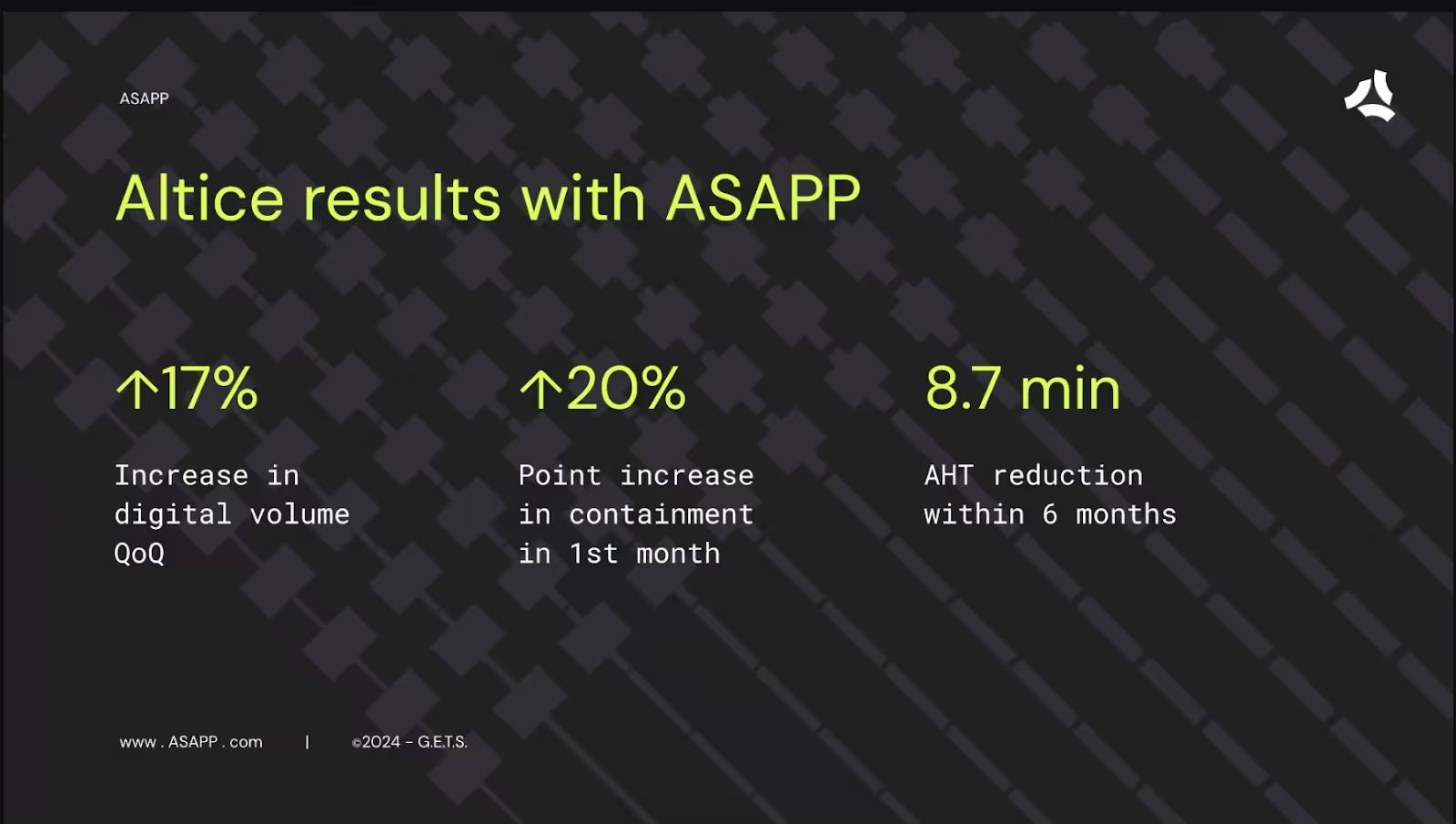Navigating any legacy platform transition can be nerve-wracking with little wiggle room for mistakes. As organizations increasingly adopt AI-powered solutions to enhance their customer experience, smoothing the process of switching platforms and optimizing user interactions requires careful planning, prioritization, and collaboration.
In the second installment of our two-part series based on a discussion between Melissa Price, VP of Customer Experience for Digital Self-Serve at Altice and Justin Mulhearn, Head of Solutions Engineering at ASAPP, we delve into the nuances of digital messaging platform transitions. Together, they share insights on overcoming challenges such as timing constraints, balancing automation with human support, and ensuring a smooth shift to a more advanced AI native platform. Through their experiences, they outline best practices for achieving long-term success while keeping user needs at the forefront.
Read Part 1: Why Altice switched messaging platforms: addressing flexibility, access, and support
* Minor edits have been made to the transcript for clarity and readability.
Adapting AI-powered messaging for user needs
Nick (moderator): We spoke earlier in the week, Melissa, about some of the ways we phased out the switch from your previous digital messaging platform to an AI native platform, or even just thinking about how to start and how to optimize over time.
I'd love for you to talk a little more in detail about how we got there, some of the things that were surprising, or moments when you had to prioritize this first, then get to other things later, while keeping the longer-term plan in mind.
Melissa: So some of the areas we delved into first were really about ensuring we're providing the right intent identifications, as we talked about earlier, and that we're in all the right places. The entry points were important to us to make sure we're there when customers need us and not just in the background, hoping the customer discovers us.
Being present in those moments that matter is something we continue to refine.
Whether that's in the app as backup support, leveraging chat there, or through our website, making chat available there. One example on the website is when customers are logged out and, say, they forgot their username or password and can’t log in to pay their bill. Being there in the moment to offer chat as the next line of support helps resolve the login issue or route them to an agent to resolve the issue more directly.
Balancing automation and human support
Melissa: Those were the types of things we wanted to uncover—what opportunities exist to drive more containment, where we can offer a quick reply or bot-based solution to the customer. Or if it reaches the next level of support, how do we identify those opportunities and get them directly to an agent?
Containment was definitely one of our goals that we reached, but containment in the right places and in the right way, I would say, not to misinterpret that stat. In some cases, containment is not a good option, and we need to rely on our chat agents to deliver the best experience.
Then there’s the surfacing of the entry point. Those are two big areas I’d highlight: intent identification and, up front, making sure customers can get to the right flow and resolution path as quickly as possible. That's also part of the consideration in terms of what's driving the AHT reduction.

Nick: Yeah. It goes to the idea of focusing on the long-term gains. When you're optimizing and not pushing containment when it's not the right situation, that makes them come back to the channel, enjoy your brand, and have a delightful experience. So, thank you for sharing that.
Tips for navigating digital messaging platform transitions
Nick: But as I mentioned earlier, there's a lot of inertia. We know that moving a platform can be scary. Oftentimes, you're trying to manage timing considerations. So, I just want to say that we are mindful of the position you're in.
We've built it to allow you to get quick value and set up in under eight weeks. I know that’s a difficult thing for some other platforms to achieve, but you made the transition recently, Melissa. Justin, you've seen this a bunch of times. I’ll start with you, Justin. Do you have a few things in mind or some pointers on how to make these kinds of transitions easier, or even things people in our audience considering a platform switch should be thinking about?
Justin: Yeah, every situation's different, but thinking about some of the themes I’ve seen, the first piece of advice I would give is, at least in the beginning, skip the channels that aren't getting much use. I remember a couple of years ago when Google Business Messages was coming on the scene to compete with Apple Messages for Business, and everyone was excited about Facebook Messages as a support channel, and the same for Twitter DMs. If I look at 2024, those probably aren’t the areas getting the most attention. Google Messages is either turned off or soon to be defunct.
So I think about prioritization. If your customer base is in Latin America, WhatsApp should be your focus. If they’re primarily in the United States, maybe that’s not something you do on day one.
It’s about ordering priorities correctly and doing what will give you the biggest bang for your buck.
I would also say, as Melissa mentioned earlier regarding intents, you don’t necessarily need to replicate all your old flows when moving to a new platform. There’s definitely a place for classic deterministic flows. For something simple like, “What’s my bill balance?” you don’t need an LM to handle that. Sometimes, you may just want to navigate through a mini-system.
But as you look at your old deterministic flows, maybe you’ve got fifty in the old platform, but only need to bring over ten. For the rest, you can look to generative AI to handle those. Use that as an opportunity to save work and uplevel the experience.
The last thing would be embracing AI and machine learning for efficiency. Of course, I’m thinking about ASAPP’s platform here. There are many capabilities baked in, like giving agents a recommended response at the next turn of the conversation, or passing a question to a bot through automation.
There are opportunities like that, which are basically a training difference. It’s worth spending the time and giving agents the opportunity to use those tools so you can see that big efficiency bump as you transition.
Nick: Melissa, if I remember correctly, when we were engaging in that transition, timing was pretty important. I think we had a tight deadline. Could you tell us a bit more about that? And if you were giving advice to someone in the audience who’s in the same shoes you were in a year and a half ago, what kind of advice would you give them?
Timing for a successful digital messaging platform launch
Melissa: Yeah, I mean, that’s one of the more nerve-wracking things when you're transitioning — making sure you hit that deadline because you’re cutting off your old platform, and moving on to the new one, with very little wiggle room for mistakes.
What was important to us as we thought about the planning behind it was making sure that, between ASAPP, my team on the digital side, and our IT teams, we were all aligned on that plan.
We were all aligned on the timing and what the level of effort would be to do that. Grounding ourselves first on what was truly MVP for this launch, and making sure we took into consideration if it was just a like-for-like? Or if there was room for a like-for-better? Do we have room for like-for-better? So those were some of the things we were looking at, and then what the use cases were if there was an opportunity to augment the platform a little bit more on day one.
But then when it came to actual execution and delivery, just really making sure that you’re running point and the partnership - there is the important piece again to highlight that. But they said one of the things that we appreciated was the extra level of effort that kinda went into them, like, really leaning in on that transition plan and making sure that we were able to meet that deadline. It came from our teams as well.
People wear many hats when it came to that last two to three weeks time period to make sure that we got all of our testing done and passed on time. And, I mean, happy to report, we launched with no major defects. There was one defect that we had post launch, and it was a small one. So it was really because of the collaboration across the teams.
Nick: I love to hear that. I mean, it really was a collaborative effort. I love hearing stories of customers saying that we're a good partner in helping with that. I think it touches on something that Justin mentioned earlier. It's not just the product and the features.
It's actually the partner that you get in the platform vendor.
I think it's a big part of how we think of things and how we support our customers.




